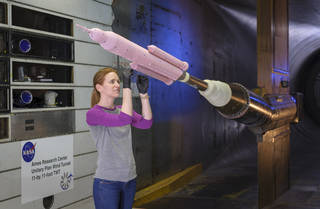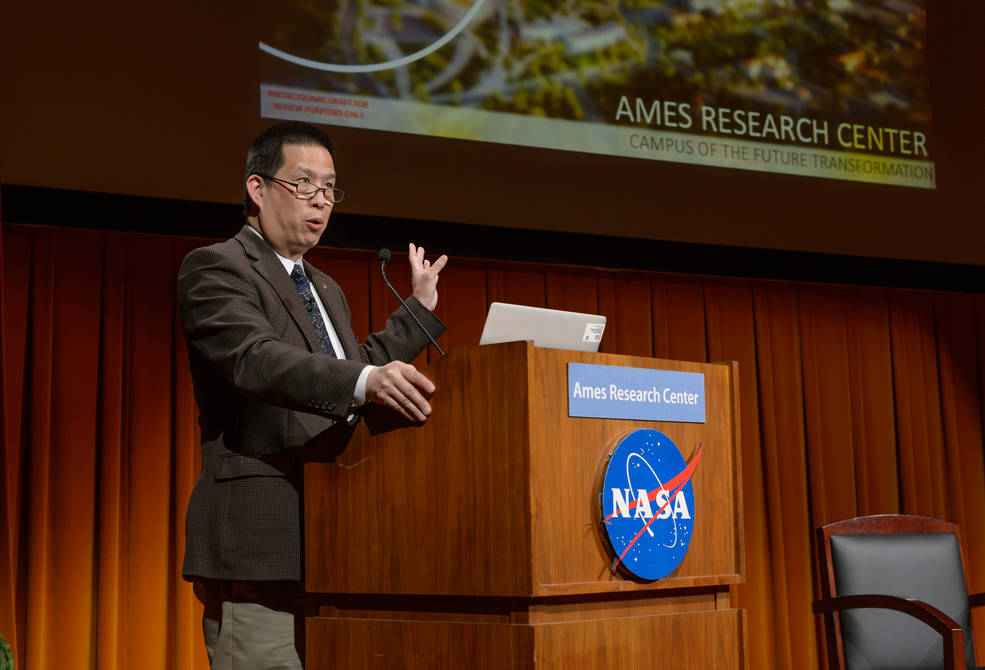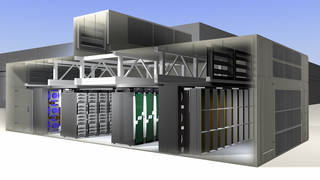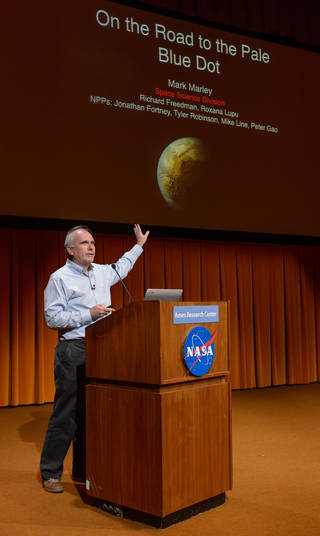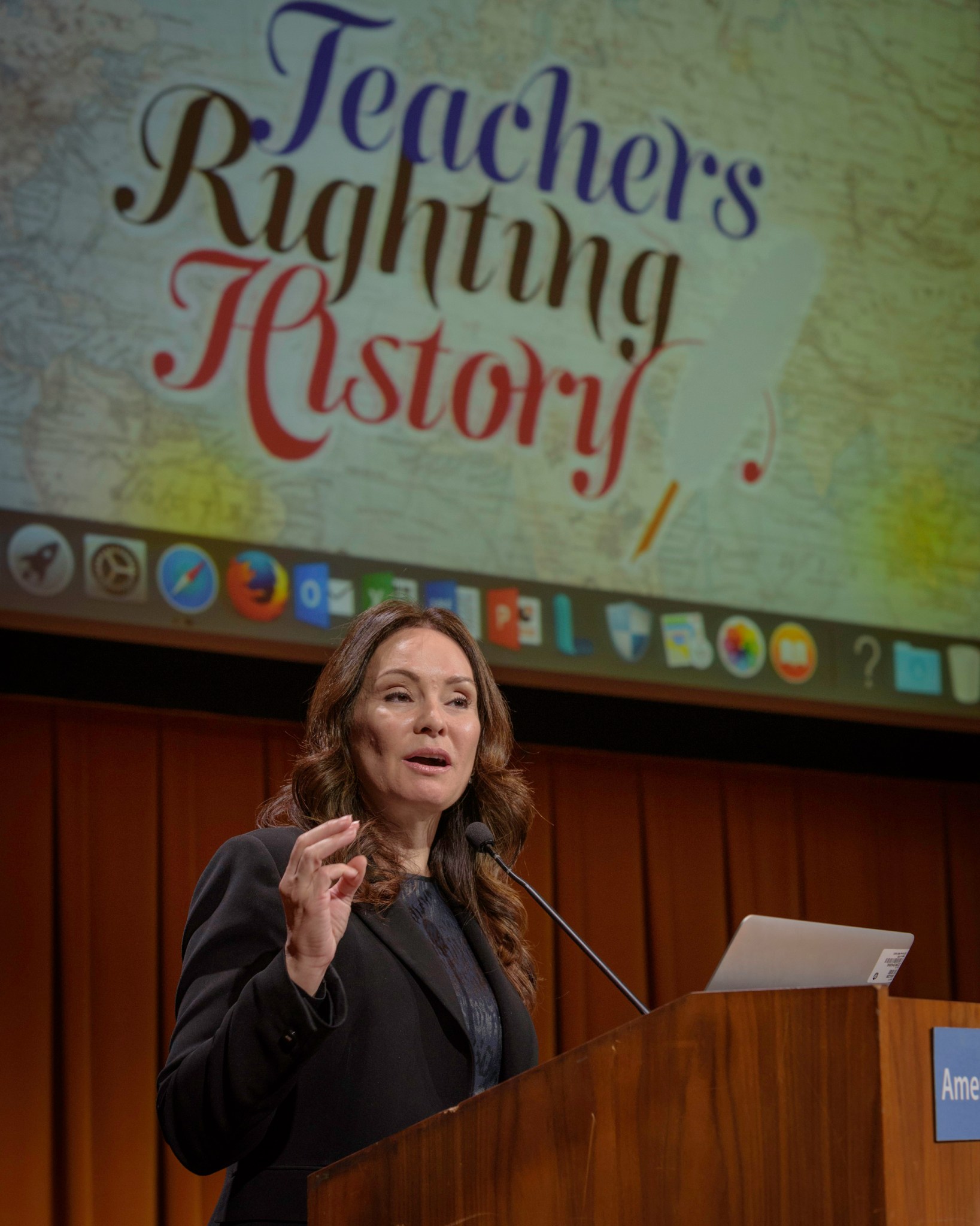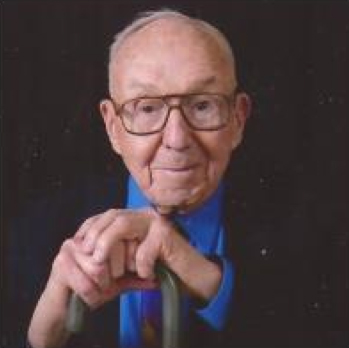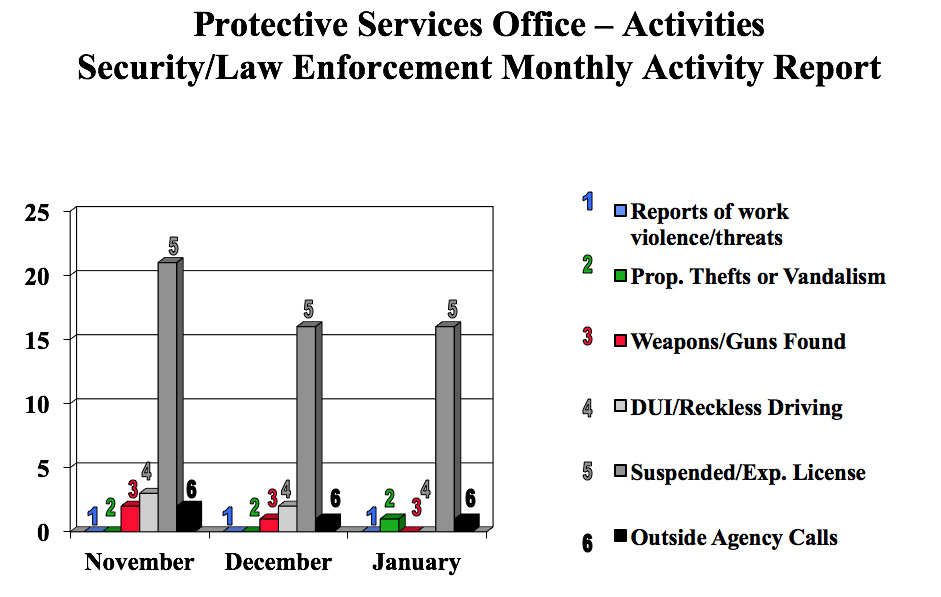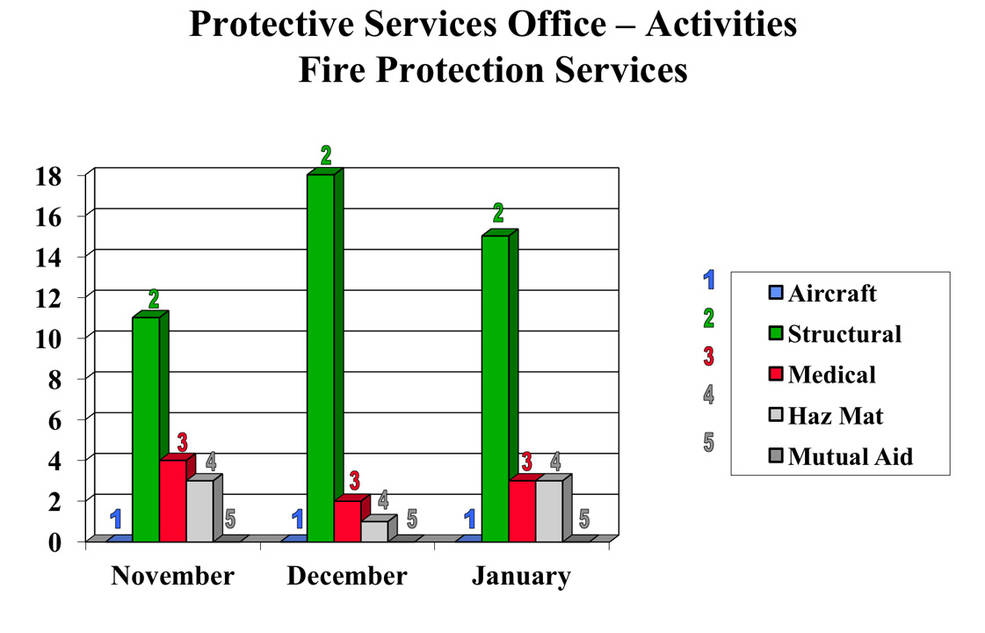Fluctuating Forces of Flight Captured by New, High-Tech Paint
by Abigail Tabor
As it thunders upward through the Earth’s atmosphere to carry a spacecraft into orbit, a rocket is buffeted by a chaotic flow of air. At high speeds, airplanes experience a similar, unsteady flow of air over their wings. This creates considerable pressure forces that change rapidly in strength and direction, especially at or near the speed of sound.
Aerospace researchers at NASA Ames are refining a state-of-the-art method to precisely measure these fluctuating forces. The secret to their technique lies in a new breed of pressure-sensitive paint (PSP), called Unsteady PSP, which emits a bright crimson glow in the presence of high-pressure airflow.
During a simulated flight through the planet’s atmosphere in the powerful airflow of a wind tunnel, this technology lets researchers capture measurements fast enough to keep up with rapidly changing pressure loads over the entire surface of the vehicle model. Obtaining such accurate data is the first step in understanding how a vehicle’s structure will respond to buffet in flight and in minimizing the impacts through design.
Pink Paint for the Red Planet
The Space Launch System (SLS) will be the workhorse rocket for NASA’s Journey to Mars. The second generation of SLS will have a 105-metric-ton lift capacity and carry NASA’s Orion spacecraft with crew plus cargo. Initial testing suggested the buffet loads that would affect the rocket during flight could be sufficient to require redesign of critical structural components.
“To help verify the buffet estimates, we had to measure this unsteady air flow more accurately,” said Jim Ross, an aerospace engineer in the Experimental Aero-Physics Branch at Ames.
The traditional method for approximating fluctuating pressure loads on aircraft involves many small microphones – up to 400 – installed on the surface of a scale model to be studied in a wind tunnel. This can be complex and costly, and only affords partial coverage.
When the original pressure-sensitive paint came along, the coverage it offered was a huge improvement. However, since it was designed to measure steady pressure, the data it provided represented averages over time, as opposed to truly capturing the fluctuating pressure itself. So, Ross and his NASA Ames colleague, Jayanta Panda, asked themselves how they could pin down the real numbers on these ever-changing pressure loads.
For entire article, visit: https://www.nasa.gov/ames/feature/fluctuating-forces-of-flight-captured-by-new-high-tech-paint
Ames Employees Updated on Current and Future Affairs at the Center
NASA Saves Energy and Water with New Modular Supercomputing Facility
by Kimberly Williams
Though there’s been some recent relief in California’s long-standing drought, water conservation techniques continue to be a hot topic for facilities that require significant amounts of water for day-to-day operations. The task of powering up and cooling down a high-end computing facility consumes large amounts of electricity and water. NASA is adopting new conservation practices with a prototype modular supercomputing facility at NASA Ames. The system, called Electra, is expected to save about 1,300,000 gallons of water and a million kilowatt-hours of energy each year, equal to the annual energy usage of about 90 households.
“This is a different way for NASA to do supercomputing in a cost-effective manner,” said Bill Thigpen, chief of the Advanced Computing Branch at Ames’ NASA Advanced Supercomputing (NAS) facility. “It makes it possible for us to be flexible and add computing resources as needed, and we can save about $35 million dollars—about half the cost of building another big facility.”
For entire article, visit: https://www.nasa.gov/ames/feature/nasa-ames-kicks-off-pathfinding-modular-supercomputing-facility
AIAA Announces its Yearly Honors, Awarding Three Employees from Ames
by Glenn Bugos
The American Institute of Aeronautics and Astronautics (AIAA) recently announced their honorees, including three Ames people.
Walter Vincenti was awarded the Guggenheim Medal, perhaps the premier recognition for a lifetime of achievement in the advancement of aeronautics. This award was established in 1929 and is now administered by the AIAA, on behalf of the American Society of Mechanical Engineers, the Society of Automotive Engineers and the American Helicopter Society. Vincenti was employee number five at Ames, working in high speed aerodynamics from 1940 to 1957. He then moved to Stanford University, where he educated generations of future Ames employees in their revitalized Aeronautics and Astronautics Department. He is now a leading historian of technology.
Karl D. Bilimoria was named an AIAA Fellow, recognizing his “outstanding contributions advancing the research and development of the next-generation air transportation system.” Bilimoria joined the staff of Ames in 1994, was a co-inventor of the Future Air Traffic Management Concepts Evaluation Tool (FACET) and serves as group lead for advanced air traffic flow management systems in the Flight Trajectory Dynamics and Controls Branch. He is active in AIAA publication efforts and serves as Editor-in-Chief of AIAA’s Journal of Air Transportation.
AIAA Fellows are “persons of distinction in aeronautics or astronautics, who have made notable and valuable contributions to the arts, sciences or technology thereof.” The Fellows will be honored at a special awards dinner on May 3, 2017, in Washington, D.C. For more information see: http://www.aiaa.org/Fellows2017/
Misty Davies was named an Associate Fellow, and received her award at the recent AIAA conference on Jan. 9, 2017, in Grapevine, Texas. Davies is a computer research engineer working at Ames in the Robust Software Engineering Technical Center. She also is group lead for the Systems, Thinking, Architecture and Collaboration group, and serves as the quality assurance lead for the SMART-NAS Test Bed.
The AIAA member grade of Associate Fellow recognizes individuals “who have accomplished or been in charge of important engineering or scientific work, or who have done original work of outstanding merit, or who have otherwise made outstanding contributions to the arts, sciences, or technology of aeronautics or astronautics.” An Associate Fellow must be an AIAA Senior Member with at least 12 years experience and be recommended by three current Associate Fellows.
The call for nominations for the next class of Associate Fellows has just opened: https://www.aiaa.org/AssociateFellowNomination/?terms=associate%20fellow%20nomination
Panelists Share Perspectives Impacting African American Students
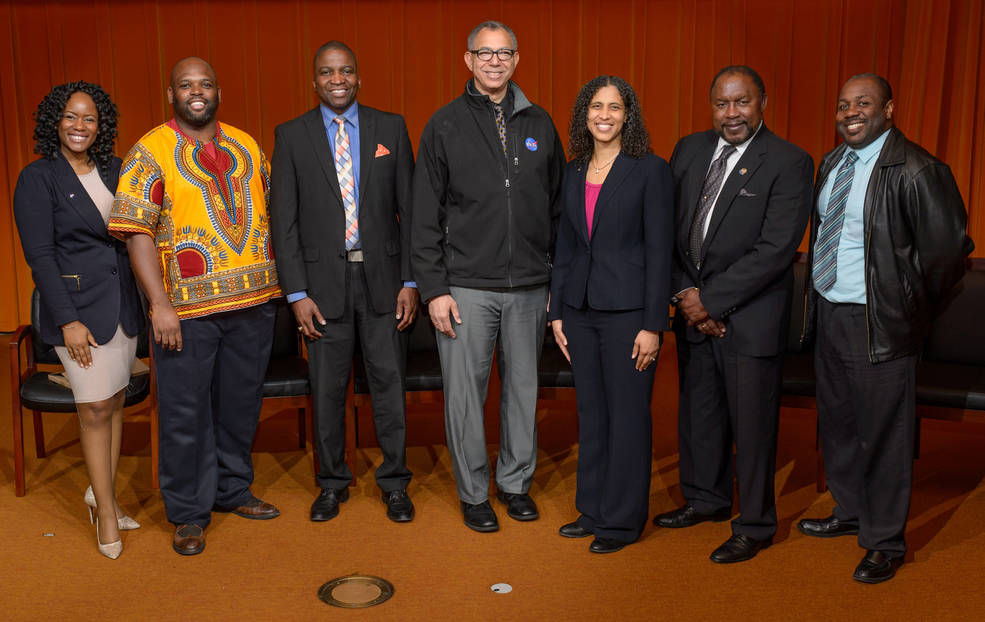
“On the Road to the Pale Blue Dot” Seminar Presented by Mark Marley
On Feb. 23, 2017, Ames Associate Fellow Dr. Mark Marley presented the seminar, “On the Road to the Pale Blue Dot.” Marley, a research scientist at Ames, specializes in the study of atmospheres of giant planets and brown dwarfs and has published more than 170 refereed papers in these fields. He has served on multiple committees charged with advising NASA on the design requirements for future exoplanet imaging space telescopes, including the WFIRST (now in Phase A) and LUVOIR space telescopes. Exploring the worlds beyond our solar system may help us answer the age-old question: Are we alone? NASA Ames has played a key role in the discovery and mapping of thousands of exoplanets in our galaxy.
In his presentation, Marley spoke about the direct-imaging method for exoplanet discovery and characterization. He reviewed the progress of exoplanet discovery and characterization, focusing on direct imaging methods. He explained the methods for characterizing directly imaged planets and highlight the successes from ongoing efforts to discover young giant planets from ground based telescopes. These initial studies are key to testing and developing the instrumental and theoretical approaches that will ultimately be needed to discover and characterize habitable planets and survey them for signs of life.
Twenty years after the discovery of extrasolar planets we now know of thousands of new worlds. Almost all of these planets were discovered by indirect means, primarily transit and radial velocity observations. In the next two decades, however, NASA aims to launch space-based telescopes with the means to directly image Earth sized and larger planets around nearby stars. The advantage of such methods is that, unlike transit methods, the light from the planet is measured separately from that of the star, allowing in depth characterization of the planetary atmosphere and perhaps surface.
The Ames Associate Fellow is an honorary designation to recognize exceptional scientific or engineering research by Ames staff members. Marley is an expert in the field of atmospheric science theory and modeling. He is recognized, in part, for his work on the interiors of solar system gas giants and the dynamic atmospheres of brown dwarf stars.
Seminar Showcases Origami Techniques Used in Engineering Concepts and Designs
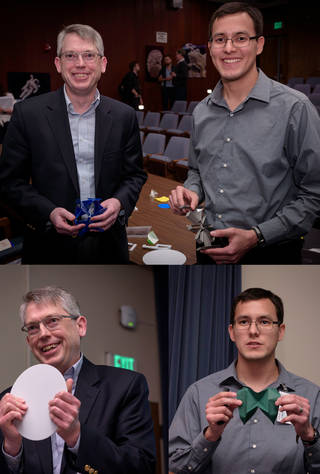
On Feb. 22, 2017, the seminar, “Origami Art and Engineering: Surprising Opportunities for Systems with Unprecedented Performance” was presented by Dr. Larry L. Howell and Alden Yellowhorse. Designs inspired by origami, the ancient Japanese art of paper-folding, are revolutionizing the fields of robotics, civil engineering and construction. In space exploration, this approach provides a technique to develop deployable and reconfigurable systems which may minimize launch volume, mass and mission cost. In their presentation, Howell and Yellowhorse showcased engineering concepts and designs developed using origami techniques.
For centuries, origami artists have invested immeasurable effort developing origami models under extreme self-imposed constraints (e.g. only paper, no cutting or gluing, one regular-shaped sheet). The accessible and formable medium of paper has enabled swift prototyping of vast numbers of possible designs. This has resulted in stunning origami structures and mechanisms that were created in a simple medium and using a single fabrication process (folding). The origami artists’ methods and perspectives have created systems that have not previously been conceived using traditional engineering methods. Using origami-inspired methods, it may be possible to design origami-like systems, but using different materials and processes to meet emerging product requirements. This presentation highlighted research in origami-based engineering at Brigham Young University, including research in deployable systems.
Larry L Howell is an Associate Dean and Professor at Brigham Young University (BYU). Howell’s research focuses on compliant mechanisms, including origami-inspired mechanisms, space mechanisms, microelectromechanical systems and medical devices. He is the co-editor of the Handbook of Compliant Mechanisms and the author of Compliant Mechanisms published by John Wiley & Sons.
Alden Yellowhorse is a PhD candidate at Brigham Young University and the recipient of a NASA Space Technology Research Fellowship (NSTRF). He was a visiting technologist at the NASA Jet Propulsion Laboratory (JPL) during the summer of 2016. Before working at JPL, he was a teacher with American Indian Services in the summer of 2015. He taught a course on engineering that was focused on Native American middle school students living in and around Blanding, Utah. Currently, he is a researcher in the Compliant Mechanisms Laboratory and studies the design of origami-inspired mechanisms and related concepts such as rigid-foldability.
Hidden Figure Computers Discuss Life at Ames in the 1960s
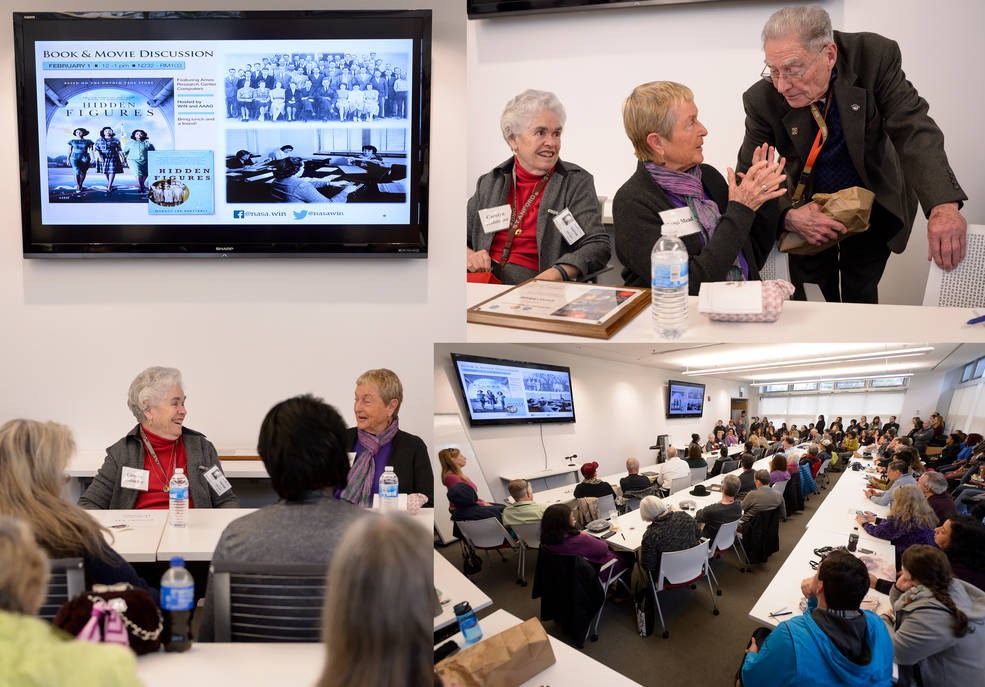
Rios, 43rd US Treasurer, Presents “Intersections Between Tech, Democracy & Future Leadership”
The Women’s Influence Network (WIN) and the Hispanic Advisory Committee (HACE) hosted a presentation at Ames by the 43rd Treasurer of the United States, Rosie Rios on Feb. 8, 2017. Rios served for nearly seven years as treasurer and currently is a Visiting Scholar at the Radcliffe Institute for Advanced Study at Harvard University. She is most recently known for initiating and leading the efforts to place a portrait of a woman on the front of U.S. currency for the first time in the nation’s history.
Rios continues advocating for women and girls as she prepares to launch her Empowerment 2020 initiative and its first project, Teachers Righting History, in 2016. Teachers Righting History is an educational project that highlights historic American women in classrooms across the country. Using a database of information collected by the U.S. Department of Treasury’s recent effort to redesign the nation’s currency, teachers and students have the ability to discuss and post images (or other creative concepts) of historic American women in their classrooms as a teaching tool. For more information, visit: http://teachersrightinghistory.org/
Ames Program Manager Michael Fletcher Reconnects with Ames Alumni in Japan
by Margo Grimme Eule
Last month, Ames Program Manager Michael Fletcher reconnected with two Japanese scientists he worked with at Ames more than 20 years ago. Fletcher has been in Japan since July 2016 as part of the Mike Mansfield Fellowship Program, which provides ten months of placements primarily in Japanese government agencies. Since arriving in Japan last summer, Fletcher has had placements with Japan’s Ministry of Education, Culture, Sports, Science and Technology; Ministry of Defense; and National Space Policy Secretariat, Cabinet Office.
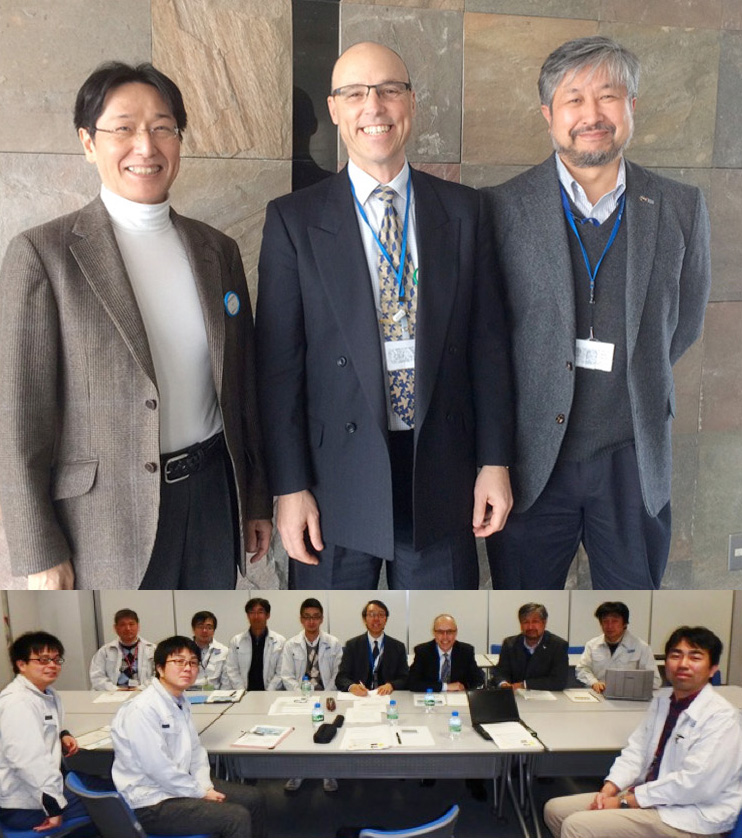
In January, Fletcher began a new placement at the Japan Aerospace Exploration Agency (JAXA). One of his first meetings at JAXA was with the CFD (Computational Fluid Dynamics) group and Yuichi Matsuo, the director of JAXA’s Numerical Simulation Research Unit. Fletcher knew Matsuo when he was a researcher studying at Ames in 1992. He and Matsuo later met with Shigeru Obayashi from Tohoku University. Obayashi was at Ames from 1986 to 1994 and worked with Fletcher on CFD research projects. Currently, he is a member of an independent review panel that provides critical review and recommendations to Matsuo on JAXA’s computational sciences research work. Their January meeting was the first time Fletcher, Matsuo and Obayashi had been together since 1992.
Fletcher’s current placement is in JAXA’s Aeronautical Technology Directorate; in February he will move to JAXA’s New Enterprise Promotion Department. His placements at JAXA will enable him to enhance NASA-JAXA partnership in aero research opportunities. His overall objective for his Mansfield Fellowship is to develop a comprehensive understanding of key Japanese government office roles and responsibilities that are central to scientific policy, research and development within the aerospace sector.
The Mike Mansfield Fellowship Program was established by Congress in 1994 to build a corps of U.S. government officials with substantial Japan expertise. The Mike Mansfield Program is administered by the Maureen and Mike Mansfield Foundation — a 501(c)3 organization that promotes understanding and cooperation in U.S.-Asia relations — with funding from the U.S. Department of State. Fletcher is part of a Mansfield Fellowship network that now includes 150 Fellows representing 28 U.S. agencies, commissions and the U.S. Congress.
In Memoriam …
Former Ames Aeronautical Engineer Clyde Quintin Allen Passes
Clyde Allen passed away Jan. 30, 2017, at Good Samaritan Hospital in San Jose at the age of 96. Clyde had a long, full life and had many stories to tell to just about anyone who would take the time to listen. He was a long time resident in the area and known by many people in the local community and outside the Bay Area as well.
Clyde was born in Modesto, California and was famous for saying that he arrived before the doctor did! In the 1930s, his family moved to Campbell, California and lived in a home on Central Avenue. He graduated from Campbell High School and went in to the US Army Air Corp. during World War II as a co-pilot of B17 and B29 bomber planes in the Pacific Theater.
After the war, he went back to school to earn his degree in aeronautics. Clyde married Dorothy Barlow in 1946 and they purchased a home in San Jose in 1955. They were among the first people to move to the area and most of the surrounding property was orchard at that time. In 1962, they welcomed their son, Stephen and they stayed in that location the rest of their lives. Dorothy passed away in 1998 at the age of 80 years old.
Clyde worked for NASA Ames as an aeronautical engineer until he retired after about 35 years. They couldn’t keep him away though and he returned as a contractor until he retired for good in 1990. He worked on many important projects here such as the space shuttle and other space vehicles as well as some of the most modern fighter jets of the time.
Once retired, Clyde kept busy by tinkering and repairing things in his garage and volunteered with a program that picked up excess food from various supermarkets and delivered it to homeless shelters to feed the needy. He always said that here in the Santa Clara Valley, no one should have to go hungry and he helped to make that a reality for many people. He also participated in the Sons in Retirement group. He served as their treasurer for many years and also was active in the First United Methodist Church of Campbell. He was one of the first members of their congregation and was always willing to help out there when needed.
Clyde Allen is survived by his son, Stephen along with Stephen’s wife Sheri and Clyde’s grandson Benjamin of Campbell. He also is survived by his brother Loren, of Santa Barbara and his sister Mae, of Rio Del Mar.
He will be missed, but we take comfort and pride in the ways Clyde touched the lives of many people during his long life. We wish him peace. He left us with many good examples to follow.
Clyde is now next to Dorothy at Los Gatos Memorial Park in San Jose and they can be together again in Heaven.
A Memorial Service is to be held at his church on Friday, Feb. 24, 2017 at 1:00 p.m. at
Campbell United Methodist Church – 1675 Winchester Blvd, Campbell, CA 95008
https://www.yelp.com/biz/campbell-united-methodist-church-campbell




























